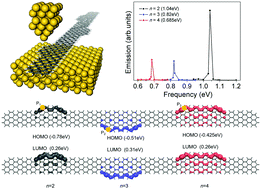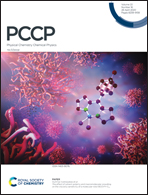Controlling the emission frequency of graphene nanoribbon emitters based on spatially excited topological boundary states†
Abstract
Graphene nanoribbons (GNRs) with atomically precise heterojunction interfaces are exploited as nanoscale light emitting devices with modulable emission frequencies. By connecting GNRs with different widths and lengths, topological boundary states can be formed and manipulated. Using first-principles-based atomistic simulations, we studied the luminescence properties of a STM GNR junction and explored the applications of these topological states as nanoscale light sources. Taking advantage of the ultrahigh resolution of the STM tip, direct injection of high energy carriers at selected boundary states can be achieved. In this way, the emission color can be controlled by precisely changing the tip position. The GNR heterojunction can therefore represent a robust and controllable light-emitting device that takes a step forward towards the fabrication of nanoscale graphene-based optoelectronic devices.

- This article is part of the themed collection: 2020 PCCP HOT Articles


 Please wait while we load your content...
Please wait while we load your content...